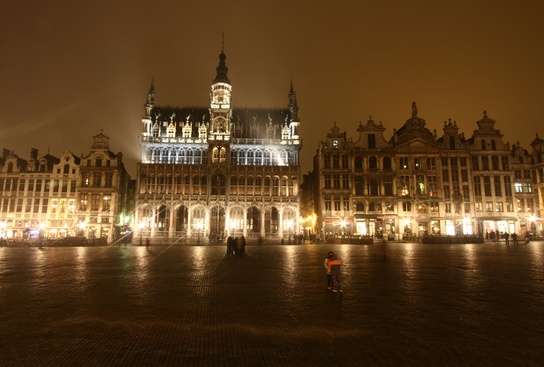Grand Place is the central square of Brussels. It measures 68 by 110 metres (223 by 361 ft), and it is a UNESCO World Heritage Site. At the beginning of the 13th century, three indoor markets were built on the northern edge of the Grand Place; a meat market, a bread market and a cloth market.
The Brussels City Hall was built on the south side of the square in stages between 1401 and 1455, and made the Grand Place the seat of municipal power. It towers 96 metres (315 ft) high, and is capped by a 4 metre (12 ft) statue of Saint Michael slaying a demon or devil.
To counter this symbol of municipal power, from 1504 to 1536 the Duke of Brabant built a large building across from the city hall as symbol of ducal power. The square was rebuilt in the following four years by the city’s guilds.
Their efforts were regulated by the city councilors and the Governor of Brussels, who required that their plans be submitted to the authorities for their approval. This helped to deliver a remarkably harmonious layout for the rebuilt Grand Place, despite the ostensibly clashing combination of Gothic, Baroque and Louis XIV styles.
The Grand Place was named by UNESCO as a World Heritage Site in 1998. One of the houses was owned by the brewers’ guild, and is now the home of a brewers’ museum.
Built in the early 15th century, the building partially escaped bombardments and underwent several transformations over time. Its ornamental programme is largely due to the restoration campaigns conducted in the late 19th century.
Facing it, the King’s House, rebuilt in the historicist vein, is perfectly integrated into the ensemble. Its elevation is in keeping with the Gothic style edifice prior to the bombardment and testifies remarkably to the ideals of the contextual conservation of monuments advocated in the 19th century.
The King’s House has been occupied for decades by the City Museum. On both sides of these monuments symbolic of public authority were houses occupied by powerful corporations.
Each different but built over a very short time, they illustrate remarkably the Baroque architecture of the late 17th century, with a singular treatment of the gables and decorations, sometimes fretted, sometimes more classical.
An architectural jewel, it stands as an exceptional and highly successful example of an eclectic blending of architectural and artistic styles of Western culture, which illustrates the vitality of this important political and commercial centre.

Scnenes of brussels belgium by night grand place lights
Over the centuries, the Place has retained its shape, coherence and the essentially Gothic and Baroque attributes which characterize it. It is still a reflection of the Lower Market as reconstructed in the late 17th century and testifies to the willingness of the authorities to preserve the harmony of the square during the rapid rebuilding campaign that followed the terrible bombardment of 1695 so that it could regain its former aspect and splendor.
These were top priorities during the restoration campaigns organized by the City from 1840 in the historicist style and during more recent operations. The City Hall still houses a significant portion of municipal services. Embellished by its bell tower, it is the most emblematic element of the square, dominating the landscape of the Lower Town.